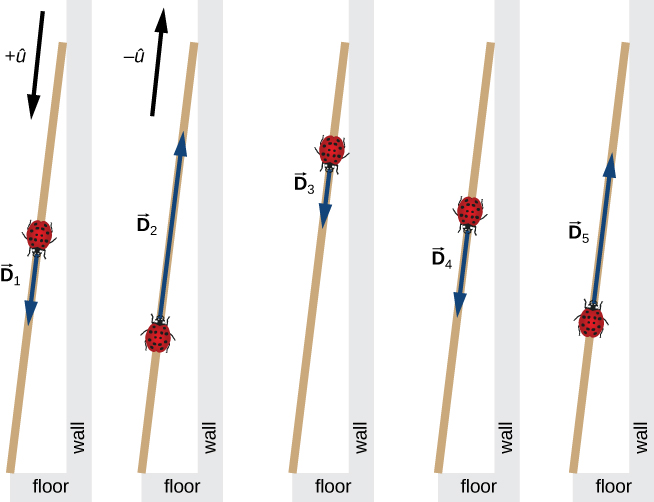| << Chapter < Page | Chapter >> Page > |
This result means your friend walked from the point where he finds his tackle box to the fishing hole.
When vectors and lie along a line (that is, in one dimension), such as in the camping example, their resultant and their difference both lie along the same direction. We can illustrate the addition or subtraction of vectors by drawing the corresponding vectors to scale in one dimension, as shown in [link] .
To illustrate the resultant when and are two parallel vectors, we draw them along one line by placing the origin of one vector at the end of the other vector in head-to-tail fashion (see [link] (b)). The magnitude of this resultant is the sum of their magnitudes: R = A + B . The direction of the resultant is parallel to both vectors. When vector is antiparallel to vector , we draw them along one line in either head-to-head fashion ( [link] (c)) or tail-to-tail fashion. The magnitude of the vector difference, then, is the absolute value of the difference of their magnitudes. The direction of the difference vector is parallel to the direction of the longer vector.
In general, in one dimension—as well as in higher dimensions, such as in a plane or in space—we can add any number of vectors and we can do so in any order because the addition of vectors is commutative ,
and associative ,
Moreover, multiplication by a scalar is distributive :
We used the distributive property in [link] and [link] .
When adding many vectors in one dimension, it is convenient to use the concept of a unit vector . A unit vector, which is denoted by a letter symbol with a hat, such as , has a magnitude of one and does not have any physical unit so that . The only role of a unit vector is to specify direction. For example, instead of saying vector has a magnitude of 6.0 km and a direction of northeast, we can introduce a unit vector that points to the northeast and say succinctly that . Then the southwesterly direction is simply given by the unit vector . In this way, the displacement of 6.0 km in the southwesterly direction is expressed by the vector
The total displacement is the resultant of all its displacement vectors.

In this calculation, we use the distributive law given by [link] . The result reads that the total displacement vector points away from the 100-cm mark (initial landing site) toward the end of the meter stick that touches the wall. The end that touches the wall is marked 0 cm, so the final position of the ladybug is at the (100 – 32)cm = 68-cm mark.

Notification Switch
Would you like to follow the 'University physics volume 1' conversation and receive update notifications?